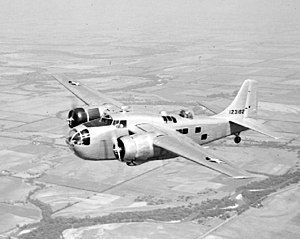

| AT-15 | |
|---|---|

| |
| Role | Bomber-crew trainer
Type of aircraft
|
| National origin | United States |
| Manufacturer | Boeing Wichita |
| First flight | 1942 |
| Primary user | United States Army Air Corps |
| Number built | 2 |
The Boeing AT-15 was an American twin-engined bomber crew trainer designed and built by Boeing's Wichita Division. Only two prototypes, designated XAT-15, were built. Plans to build over 1,000 were cancelled on the United States' entry into the Second World War.
One of the first projects for the former Stearman Aircraft Company which in 1939 had become the Wichita Division of Boeing was a twin-engined trainer for bomber crews. Designated X-120 by the company, two examples were ordered by the United States Army Air Corps as the XAT-15. The AT-15 was a high-wing cantilever monoplane with two wing-mounted Pratt & Whitney R-1340 Wasp radial engines. It had a retractable tailwheel landing gear and an extended glazed fuselage nose for the trainee bomb-aimer. Due to shortage of materials, the aircraft was built of welded steel tube covered with plywood, with wooden wings and tail unit. The two aircraft were delivered to the USAAC, but after the country's entry into the war a change in priorities resulted in the planned order for more than 1,000 aircraft not being placed.
According to Edward H. Phillips, "The aircraft's specific purpose would be to teach prospective bomber crews how to work together as a team before they were assigned to an operational unit." On 19 May 1941, Boeing signed a contract to build two of the aircraft. On 9 April 1942, the first flight occurred. In October 1942, the first XAT-15 was delivered. However, special schools for gunners, bombardiers, navigators, and pilots developed during the war, and the need for the XAT-15 disappeared. As a result, production was halted and materials salvaged.[1]
Data from [2]
General characteristics
Performance
Armament
Related lists
|
Boeing military aircraft
| |
|---|---|
| Fighters/attack aircraft |
|
| Bombers |
|
| Piston-engined transports |
|
| Jet transports |
|
| Tanker-transports |
|
| Trainers |
|
| Patrol and surveillance |
|
| Reconnaissance |
|
| Drones/UAVs |
|
| Experimental/prototypes |
|
|
United States trainer aircraft designations, Army/Air Force and Tri-Service systems
| |||||
|---|---|---|---|---|---|
| Advanced Trainer (1925–1948) |
| ||||
| Basic Combat (1936–1940) |
| ||||
| Basic Trainer (1930–1948) |
| ||||
| Primary Trainer (1924–1948) |
| ||||
| Main sequence (1948–present) |
| ||||
| Alternate sequences |
| ||||
1 Not assigned • 2 Assigned to multiple types | |||||